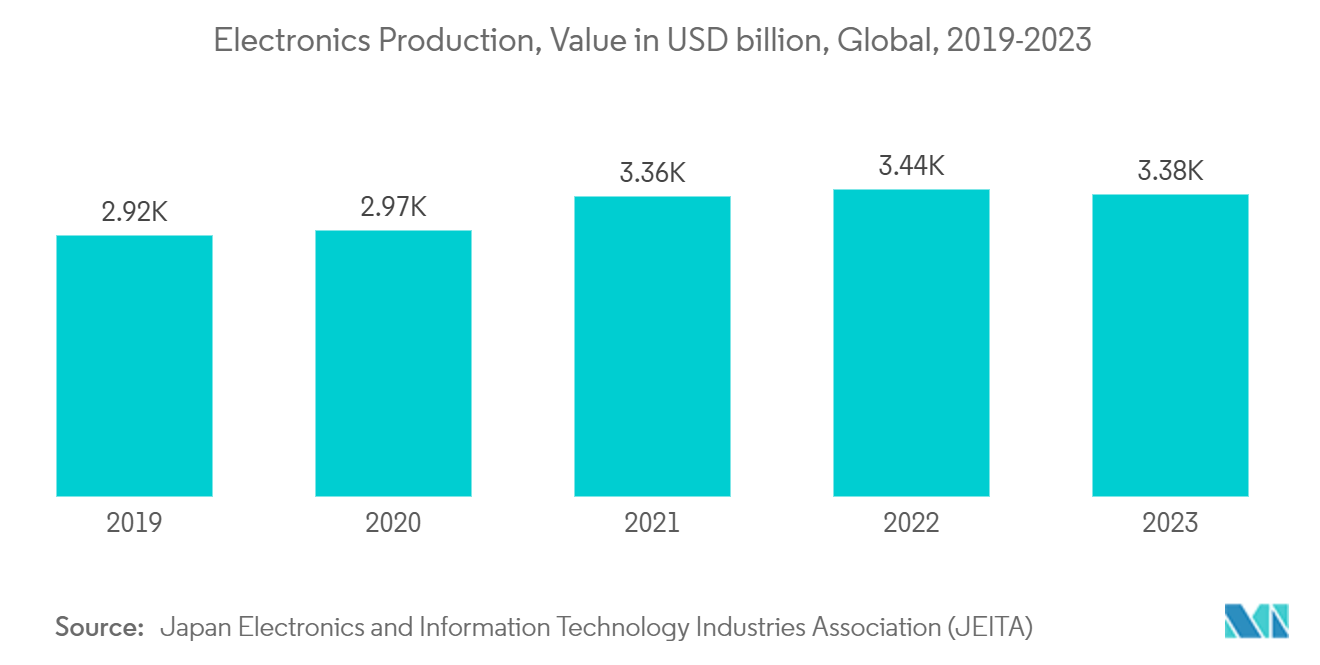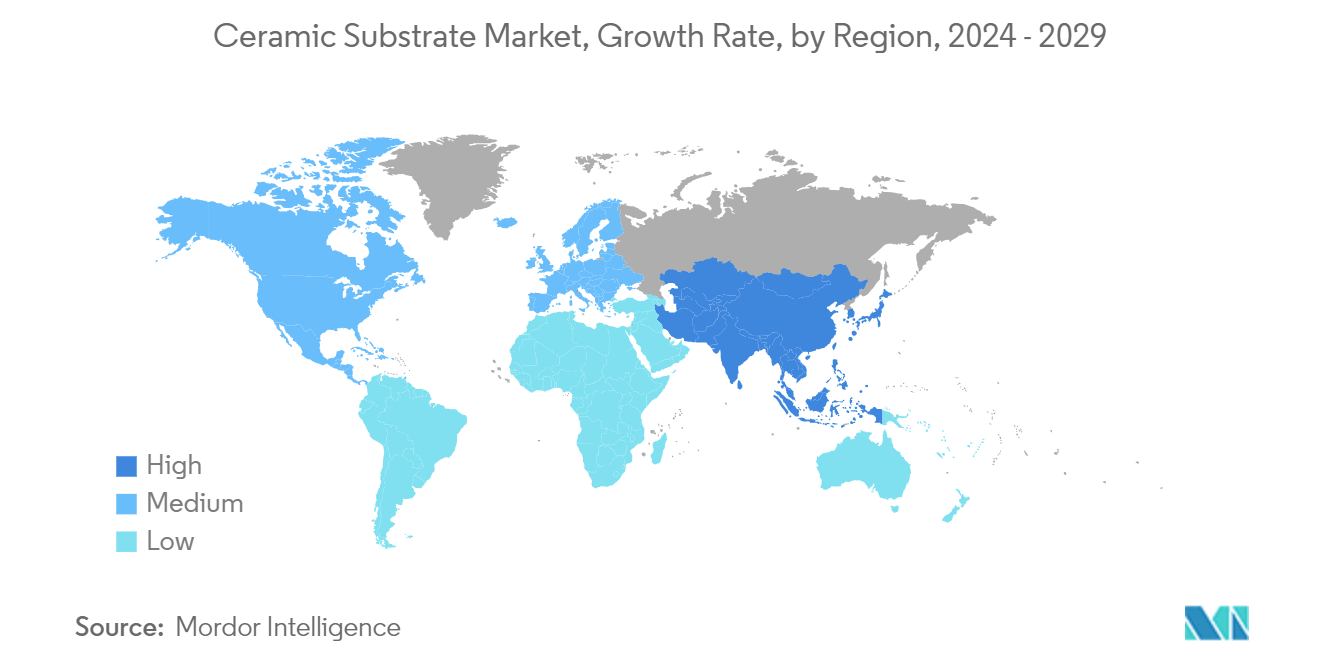Market Trends of Ceramic Substrate Industry
Rise in the Adoption of Ceramic Substrates in Electronics Application
- Ceramic substrates, known for their high strength, insulation properties, and thermal conductivity, are pivotal in electronic applications. Their distinctive features, such as a low dielectric constant and chemical stability, position them as the favored option for electronic packaging.
- Due to their excellent heat conductivity, ceramic substrates are ideal for managing heat in electronic devices. They effectively dissipate heat from components, mitigating overheating risks and enhancing device reliability.
- Ceramic substrates prevent current flow as electrical insulators, making them essential for crafting electrical circuits and avoiding shorts.
- Semiconductor manufacturers favor ceramic substrates like alumina, beryllium oxide, and aluminum nitride. These materials are integral to the semiconductor industry and are valued for their wear resistance, thermal conductivity, and high bulk resistivity, among other properties.
- Ceramic substrates offer mechanical support to electronic components, including resistors, capacitors, and integrated circuits, ensuring device integrity and preventing damage.
- The electronics industry stands as one of the largest and fastest-growing globally. In today's digital age, electronic devices profoundly influence daily life, with demand projected to rise and drive significant global economic activity.
- As per the data from the Japan Electronics and Information Technology Industries Association (JEITA), the global electronics and IT industry saw a 3% year-over-year decline in 2023, totaling USD 3,382.6 billion. However, a rebound is anticipated, with projections of a 9% growth in 2024, reaching USD 3,686.8 billion.
- China, boasting one of the world's largest electronics production bases, poses a formidable challenge to upstream producers in South Korea, Singapore, and Taiwan. In the consumer electronics segment, products like smartphones, OLED TVs, and tablets are witnessing the highest demand growth.
- As per the data from Xinhua News Agency, China's electronics manufacturing industry showcased robust performance in the initial four months of 2024, buoyed by rising production and a rebound in both domestic and global demand. Major companies in China's electronics sector, as reported by the Ministry of Industry and Information Technology, saw their combined profits surge by 75.8% year-on-year, reaching CNY 144.2 billion (~USD 20.3 billion) from January to April 2024.
- India is the second largest smartphone producer after China. As per Invest India, India aims to manufacture cell phones worth USD 126 billion by 2025-26. Globally, the demand for smartphones is increasing at a significant rate. According to the Telefonaktiebolaget LM Ericsson, the subscription is likely to reach 7,690 million by 2027, enhancing the usage of the studied market from electronics applications.
- The United States electronics sector is on a moderate growth trajectory, driven by a surge in demand for advanced technological products and rapid innovation spurred by robust R&D activities.
- In April 2024, the Department of Energy (DOE) unveiled plans to channel up to USD 331 million into a new transmission line, emphasizing union labor, as part of President Biden's Bipartisan Infrastructure Law. Moreover, the administration is spearheading a collaborative initiative with public and private leaders to bolster the nation's transmission network, targeting an ambitious upgrade of 100,000 miles of transmission lines over the next five years.
- Germany boasts the largest electronics industry in Europe and ranks as the world's fifth-largest market, as reported by the Germany Electrical and Electronics Association (ZVEI). The electronics sector in Germany contributes 10% to the country's industrial output and accounts for 3% of its GDP. Furthermore, it employs roughly 14% of the industry's total workforce. Notably, Germany allocates about 24% of its total R&D expenditure to the electronics and microtechnology sectors, which encompass semiconductor fabrication.
- Given these dynamics, the burgeoning electronics industry is poised to drive heightened demand for ceramic substrates in the coming years.

Asia-Pacific Region to Dominate the Market
- Asia-Pacific is set to spearhead the ceramic substrate market, emerging as the region with the swiftest growth during the forecast period. This upswing is largely driven by surging demands across diverse sectors, such as consumer electronics, aerospace & defense, automotive, semiconductor, and telecommunication, especially in countries like China, India, South Korea, Japan, and several Southeast Asian nations.
- In aerospace applications, ceramic substrates ensure electrical insulation for components like connectors and switches, preventing shorts and guaranteeing reliable operation. With the aerospace sector's expansion in the region, the demand for ceramic substrates is rising.
- China stands out in the global aerospace arena, leading in aircraft manufacturing and domestic air travel. The nation's aircraft parts and assembly sector is rapidly expanding, boasting over 200 small parts manufacturers.
- As per the data from the International Trade Administration (ITA), China is the second-largest civil aerospace market globally. As of January 2024, the National Bureau of Statistics of China and the Civil Aviation Administration of China reported 7,351 civil aircraft, an increase of over 550 airplanes from 2022.
- Ceramic substrates play a crucial role in automotive electronics owing to their unique properties, including high thermal conductivity, electrical insulation, and high reliability which make them an ideal material for specific uses. As vehicle production rises in the region, the demand for ceramic substrate is expected to bolster.
- In India, data from the Society of Indian Automobile Manufacturers (SIAM) indicates that from January to March 2024, the production of passenger vehicles, commercial vehicles, three wheelers, two wheelers and quadricycle reached 7.39 million units. Specifically, sales for passenger and commercial vehicles were 1.14 million and 268 thousand units, respectively.
- In the electronics and semiconductor realm, ceramic substrates are essential for applications demanding high thermal conductivity, electrical insulation, and mechanical strength. With the region's electronics and semiconductor sectors on an upward trajectory, the demand for ceramic substrates is anticipated to grow in the coming years.
- According to the India Electronics and Semiconductor Association, India's semiconductor component market is projected to achieve a valuation of USD 32.35 billion by 2025, reflecting a CAGR of 10.1%. Additionally, the government's "Make in India" initiative aims to draw substantial investments into the semiconductor sector.
- Moreover, the India Electronics and Semiconductor Association (IESA) has inked a MoU with the Singapore Semiconductor Industry Association (SSIA), aiming to foster trade and technical collaboration between the two nations' electronics and semiconductor sectors. This partnership is poised to usher in groundbreaking semiconductor manufacturing technologies, amplifying the demand for ceramic substrates in India's semiconductor production.
- Japan is home to around 30 semiconductor fabrication units, producing a diverse array of semiconductor chips. Notably, Japan's semiconductor supply chain accounts for a third of the global semiconductor manufacturing equipment and over half of the industry's materials.
- Data from the Japan Electronics and Information Technology Industries Association reveals that Japan's electronics industry produced goods worth JPY 5,452,56 million (~USD 3,386 million) from January to June 2024, marking a remarkable 104.7% growth compared to the same period the previous year.
- South Korea boasts a mature automotive industry with notable brands like Hyundai, Renault, Samsung, and Kia. Projections from the Automobile Manufacturers Association and The Korea Automobile Research Institute anticipate a 1.0% rise in domestic automobile production for 2024, reaching 4.36 million units. This growth is expected to drive demand in the studied market.
- Given these dynamics, the Asia-Pacific region is poised for a robust demand surge in the ceramic substrates market during the forecast period.


